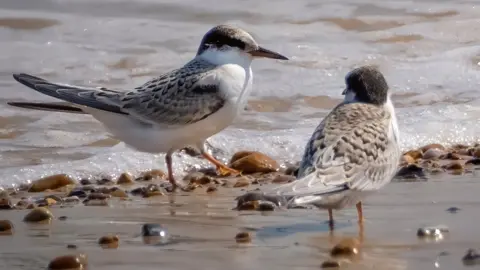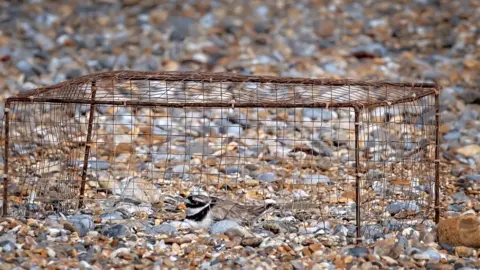Blakeney Point electric fencing and shelters help tern numbers
 Hanne Siebers
Hanne SiebersElectric fencing, bird shelters and cameras introduced at a nature reserve have helped increase its number of rare seabirds.
Blakeney Point, in Norfolk, had 49 little tern chicks fledge this year - the highest number since 2020.
The National Trust, which runs the site, said it had been a "challenging year" because of the devastating impact of avian flu.
It said "old and new" methods of conservation improved the success rate.
 Duncan Halpin
Duncan Halpin One of the UK's smallest and rarest seabirds, little terns migrate several thousand miles from Africa to breed, nesting in colonies on shingle beaches along the UK coastline.
Numbers of the birds have declined sharply since the mid-1980s due to disturbances from people and dogs, habitat loss, high spring tides washing away nests and threats from predators including foxes, rats and birds of prey.
The charity said in June there were more than 80 pairs of little terns nesting and a minimum of 49 chicks had successfully fledged by the end of the season.
 Hanne Siebers
Hanne SiebersTo encourage successful breeding, electric fencing was introduced at the Norfolk site along with "chick shelters" placed by nests, to give the terns somewhere to hide. Remote monitoring cameras were also installed.
Ranger, Duncan Halpin, said: "Nesting areas are fenced off to prevent people and dogs from getting too close to the birds.
"And this year we've combined old and new conservation methods, which we feel have helped improve the birds' success rate.
 Hanne Siebers
Hanne Siebers"Although they've had a successful year, little terns are still under threat, so it's important we keep up our efforts to ensure they have safe sites to breed."
The number of ringed plovers at Blakeney also rose to 17 pairs with 20 chicks, up from 14 pairs and eight chicks last year. There were also 89 oystercatcher pairs, up from 68 pairs a year before.
 Hanne Siebers
Hanne Siebers
Follow East of England news on Facebook, Instagram and X. Got a story? Email [email protected] or WhatsApp 0800 169 1830
